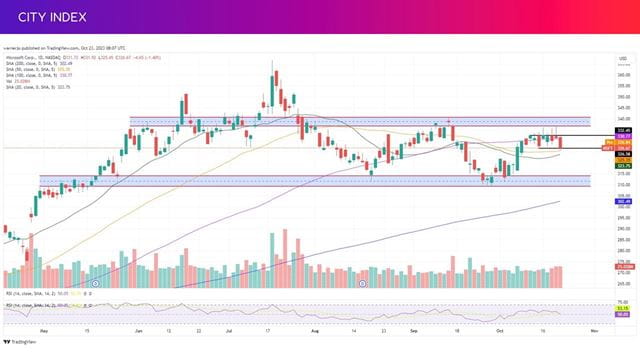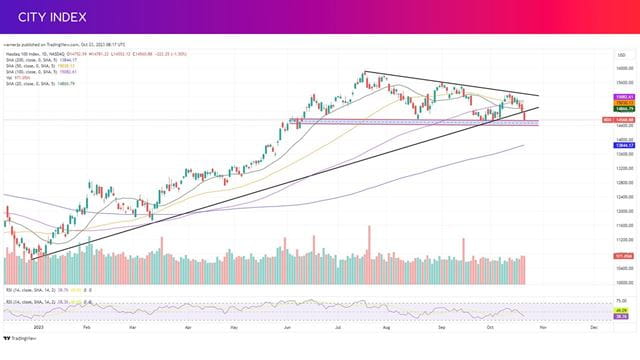
Key takeaways
- Microsoft’s diversification is paying-off, with more resilient demand for software and cloud countering weakness in hardware
- Perceived early lead in AI also helping valuation, but pressure building to deliver
- Outlook for Azure and cloud will be key
- Bottom-line to grow faster than the top thanks to better margins, but Wall Street sees risk of profitability coming under strain as AI investments and workloads ramp-up
When will Microsoft release Q1 earnings?
Microsoft will release first quarter results after markets close on Tuesday October 24. A conference call will be held on the same day at 1430 PT.
Microsoft earnings consensus
Microsoft is expected to report an 8.8% year-on-year rise in revenue to $54.5 billion and EPS is forecast to climb 13% to $2.65, according to a consensus compiled by Bloomberg.
Microsoft earnings preview
Big Tech valuations have tempered following the pullback we have seen in markets over the last two months, but Microsoft has managed to retain its premium over the Nasdaq 100 and its rivals. That is because confidence remains high that Microsoft’s diverse business - formed of a blend of software, hardware and cloud-computing - can keep outperforming.
Demand for consumer electronics remains depressed and subdued demand for Microsoft’s More Personal Computing division that sells computers, Windows operating system and Xbox gaming consoles will continue in the first quarter, with analysts predicting a 3.3% drop in sales to $12.9 billion. Importantly, markets are hopeful that the lull in demand is nearing its bottom and any confirmation would be welcome. Wall Street believes the division will return to growth in the second quarter as it starts to come up against easier comparatives.
Diversification is paying-off. Demand for Microsoft’s array of software like its Office suite of products has been more reliable and buoyant. Revenue growth has been accelerating in its Productivity & Business Processes division and sales are forecast to rise 11.1% this quarter to $18.3 billion.
Meanwhile, growth at Intelligent Cloud has slowed compared to last year but remains in double-digits, with Wall Street forecasting a 16% rise in revenue this quarter. Azure will be the most closely-watched segment considering it is growing at a faster pace, with analysts expecting a 27% rise in revenue this quarter, and it sits at the heart of Microsoft’s big push into AI using its relationship with OpenAI, which uses Azure as the backbone to run systems like ChatGPT. The outlook for Azure, cloud computing and AI will be key in deciding sentiment. Analysts are looking for Microsoft to target Azure revenue growth of 26.7% in the second quarter, and any signs it will be stronger would suggest AI demand is taking-off faster than anticipated while a weak outlook here could dampen near-term AI prospects.
Microsoft’s perceived leadership in AI, aided by its investment in OpenAI, is another reason why the company has retained a higher valuation multiple than other Big Tech companies, so delivering tangible progress on this front will become increasingly important. That not only includes its own efforts to infuse and monetise the technology in its own products and services, but the anticipated influx in demand for cloud-computing services as other companies ramp-up their AI activities.
An improvement in margins is set to allow Microsoft to grow its bottom-line faster than the top this quarter. However, Wall Street forecasts margins will come under pressure in the coming quarters as it ramps-up investment in generative AI. Microsoft could surprise here if it is able to counter higher investment with lower costs.
Where next for MSFT stock?
Microsoft has tried and failed to close above $332.50 on multiple occasions over the past week-and-a-half, making this the immediate upside goal for the stock. On the downside, there may be some support at $326, although the 50-day moving average may prove more reliable, with the 20-day there to provide a potential safety net.
Broadening the analysis out, Microsoft has traded somewhat rangebound since the pullback at the start of August. We can see a support zone between $314 and $309.50 and that it has faced resistance between $336.90 and the September-peak of $340.90.

Nasdaq 100 analysis: Where next?
Microsoft is the second largest constituent of the Nasdaq 100, accounting for almost 10% of the entire index. That means it is highly influential on how the index performs.
We can see that the Nasdaq 100 shattered through the supportive trendline that had held firm throughout 2023 on Friday, when the index closed at fresh October-lows. The wedge has been narrowing and we have now seen a breakout, which has brought the support zone between Friday’s close at 14,560 and the September-low of 14,430 back onto the radar. Any drop below this range could trigger a decline below 14,250 and set a new lower-low.
On the upside, the initial target is 14,850, representing the ceiling we saw in the back-end of last month. A move above 15,260 is needed to set a new higher-high.

How to trade Microsoft stock
You can trade Microsoft and the Nasdaq 100 with City Index in just four easy steps:
- Open a City Index account, or log-in if you’re already a customer.
- Search for the stock or index you want in our award-winning platform
- Choose your position and size, and your stop and limit levels
- Place the trade
Or you can practice trading risk-free by signing up for our Demo Trading Account.
Take advantage of extended hours trading
Microsoft will release earnings after US markets close and most traders must wait until they open before being able to trade. But you can get ahead of the game by taking a position in premarket hours by taking advantage of our service that allows you to trade Microsoft using our extended hours offering.
While trading before and after hours creates opportunities for traders, it also creates risk, particularly due to the lower liquidity levels. Find out more about Extended Hours Trading.










